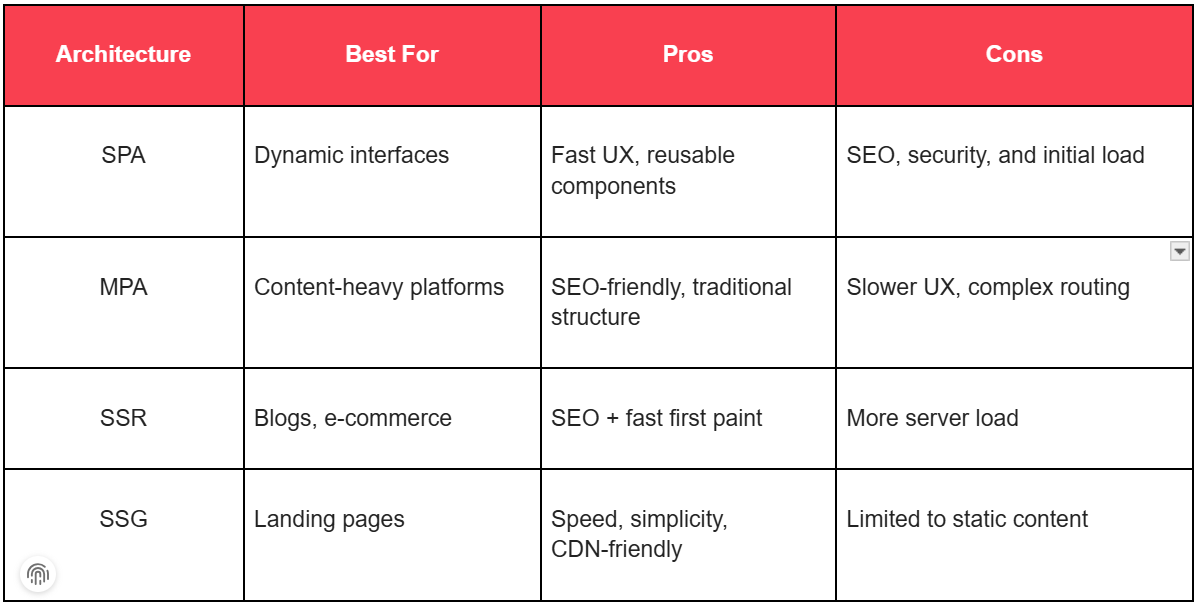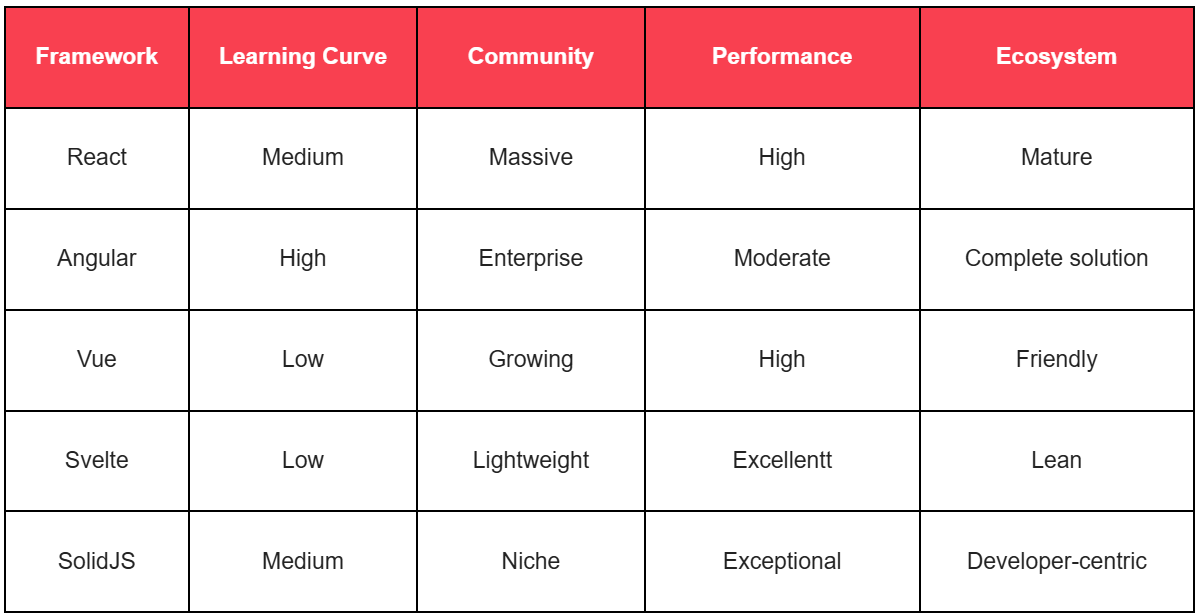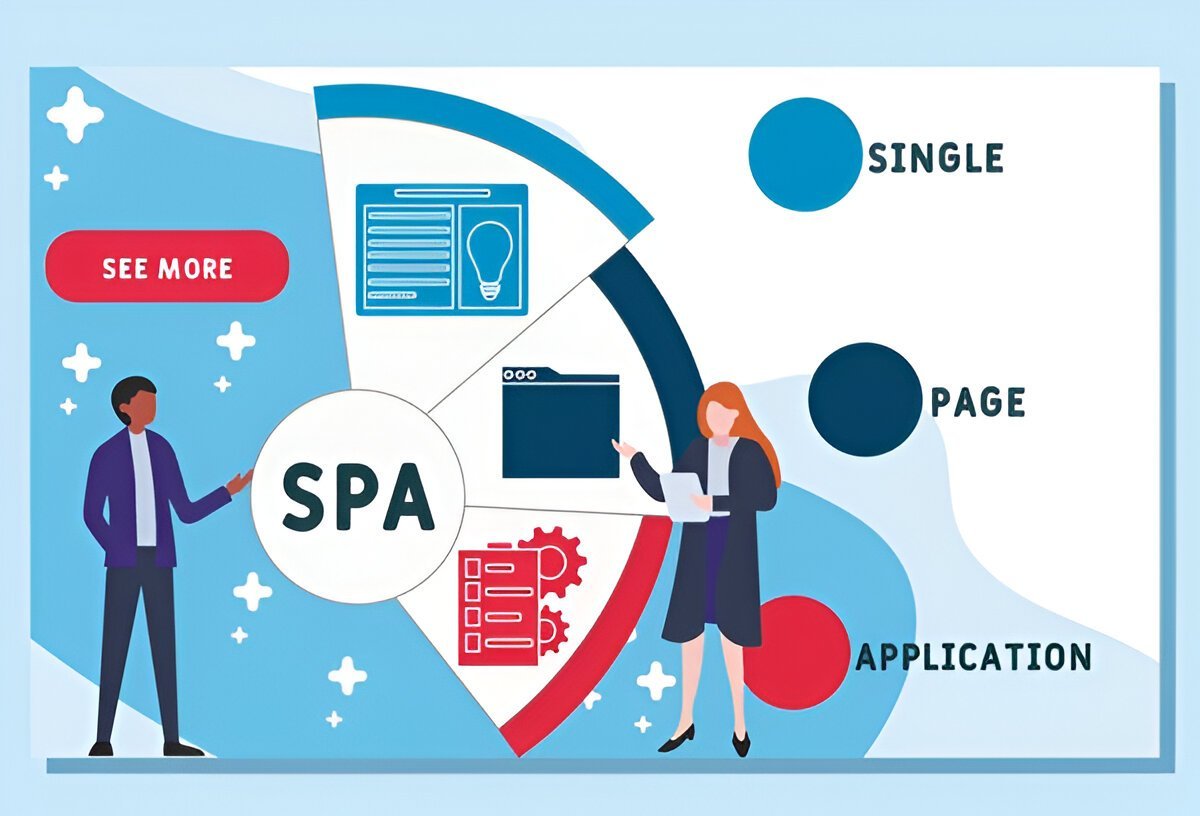Single Page Applications (SPAs) Key Characteristics
There are some popular apps like Gmail, Facebook, Twitter, and Trello that work this way. You will also notice how quick and smooth it feels when moving around. This is because most of the data is there, and only the required part will be changed and reflected on the screen. These applications use JavaScript structures (React, Angular, or Vue) to make all this happen in the backend. These techs help developers build more engaging as well as faster websites. These websites feel modern and easy to use. SPAs are built to make the web experience feel more like a smooth application, fast and easy to use.
Develop blazing-fast, unprejudiced, user-first web apps that dominate the digital experience. Single Page Applications have reshaped the very essence of interacting with modern-day websites. The moment an individual clicks a link, it is a new webpage that loads in the traditional set-up. Unlike traditional setups, SPAs operate inside a single HTML file, updating content on the fly with JavaScript. This essentially allows for a smooth and snappy navigation experience that comes close to that of a mobile or desktop application.
With the users expecting hill-sprint-fast execution and real-time response in 2025, SPAs have never been more relevant. They deliver high-performing web applications capable of keeping their users engaged and content. This is the age of business owners and developers realizing how SPAs have narrowed the user experience gap between native apps and websites.
What is Single-Page Application (SPA)?
A single-page application is basically described as a web app or a site that feels fast and smooth to use. These websites give users a touch of mobile application. These websites load everything once at the start and then only update what is needed as you go, in place of loading a brand new page every time a user clicks on something. A user can stay on the single screen the entire time.
Here is how SPA pages work:
When a user opens a page on the website, it loads the basic framework of the site. The layout, menu, and design will be the same all the time. But when a user clicks on something, for example, opening a product, checking their profile, or even switching the modules, the website will just pull the data and show that exact content in no time, without reloading the whole page from the start.
This concludes-
- User don’t have to wait for the entire page to reload
- The user gets smooth changes like flipping between screens in an app
- A user gets good experience on poor connections
Single Page Application vs Traditional:
- SPA (Single Page Application): Loads one HTML page. Navigation happens without any page refresh. The system fetches and renders data dynamically.
- MPA (Multi-Page Application): With every page, a new HTML document gets loaded. Better for content-heavy websites.
- JAMstack (JavaScript, APIs, and Markup): The front end is separated from the back end, which builds fast and secure websites, offering content via CDN.
Working of SPAs
The "Single Page Application" workings are mostly centered around client-side rendering (CSR). Therefore, upon landing on a single-page application, the user only loads the initial HTML, CSS, and a bundle of JavaScript. After this, all the data and content updates happen asynchronously in the background, possibly through Fetch API/Axios/GraphQL. In the next step, the user then interacts with the page in the way that JavaScript executes changes to applicable sections of the DOM without refreshing the page.
The SPA request lifecycle:
- The browser requests the initial document.
- The server returns a bare-bones HTML file and sends the bundled JavaScript and CSS files.
- JavaScript starts the application and then loads the initial interface.
- Interaction with a user causes JavaScript to get further data from the APIs.
- JavaScript only modifies the related elements of the UI, which prevents a complete page reload.
Key Concepts Behind SPAs:
- Virtual DOM: Allows faster UI updates by listening to changes in a virtual representation of the DOM.
- Hydration: Merges minimal HTML served by the backend with JavaScript-powered features.
Routing: The client-side routers (such as React Router and Vue Router) manage navigation and URL changes like an MPA, except without reloads.
Benefits of Single-Page Applications
1. Smooth User Experience: Users undergo seamless transitions between pages. Interactions feel instantaneous because delays due to server responses or full page reloads never occur. SPAs use JavaScript to swap views, update components, and provide instant feedback.
2. Lower Bandwidth and Server Load: Once the server is loaded, the SPA now will not request an HTML page from the server. It will rather ask for data. The bandwidth usage drops to a large extent, and the server no longer feels the load at that level. As more action and any logic happen on the customer side, the server starts getting raw data through APIs.
3. Mobile-Friendly Behavior: SPAs mimic the behavior of native apps. Hence, they favor a mobile-first implementation, such as quick transitions, offline caching with service workers, and push notifications.
4. Real-World Use Cases:
- Gmail: Users can read, compose, and navigate without having to reload the page.
- Trello: Provides the most dynamic task board of drag-and-drop and live updates.
- Notion: Works on in-app navigation with real-time updates and collaborative editing.
- Figma: The whole design studio in the browser with a high level of interactivity.
Popular examples of Single Page Application
Single-page applications have become the support system of many popular platforms that require speed, interactivity, and responsiveness. Here are some of the popular examples that show how SPAs redefine user experience in 2025:
1. Gmail -
Gmail has a UI that allows the fluid environment of communication wherein users may read, compose, and navigate between separate mails without ever triggering a page reload. Content updates with responsiveness and offline abilities make this app highly functional when a user's bandwidth is constrained.
2. Trello -
Trello is an interactive drag-and-drop task management board supported with real-time updates. Users collaborate, drag cards, and update boards at lightning-fast speed without halting for server reboots or refreshes.
3. Notion -
Notion provides navigation and live updates within the application, which gives users a smooth interface like a desktop inside their browser. It is one of the most flexible platforms if a user wants to do project management, take notes, and create collaborative workspaces.
4 Figma -
Figma is a website-based design and prototyping tool that provides a detailed space where one can edit in real time collaboratively. Although browser-based, it behaves with the speed that a true native app should behave.
5. Google Maps -
Google Maps manages way too much data but has a smooth and responsive UI, all happening from the client side. Panning and zooming are undeterred by mentions of real-time directions.
Challenges & Limitations
1. SEO Limitations: Search engines might have problems crawling SPAs if the content is rendered client-side. Solutions include:
- Use SSR frameworks like Next.js or Nuxt.js
- Prerender static content with tools like Prerender.io
- Dynamic Rendering: Serves tailored content separately to users and search engine crawlers.
2. Initial Load Time: Since SPAs pack all their scripts from the get-go, this can slow the time to first interaction. To counter this:
- Lazy loading
- Code splitting
- Progressive hydration
3. Security Concerns: Single-page apps can face a few serious threats:
- Cross-Site Scripting (XSS): Attackers manage to trick the insertion of malicious scripts that grab session or sensitive information.
- Cross-Site Request Forgery (CSRF): Some shady websites may trick a logged-in user into invoking actions without their knowledge. Most of this can be gone around by validation of inputs, sanitizing user data, making cookies HTTP-only, and putting in CSRF protection.
4. Accessibility Issues: When basic roles, keyboard support, or screen reader guidance are skipped, a chunk of users just can’t use the app properly. Testing with screen readers and sticking to meaningful HTML usually clears up most of that.
SPA vs MPA vs SSR vs SSG
Choosing the architecture will perfectly fit into the goals of the project. Consider:

A decision tree or matrix can be used to determine exactly how an application fits its needs.
Top Frameworks and Tools in 2025
Popular Libraries & Frameworks:
- React: Valued for its adaptability and strong developer community. Read react single-page application (React SPA)
- Angular: A full-fledged framework offering built-in routing, state management, and HTTP tools.
- Vue: Developer-friendly and easy to integrate.
- Svelte: Compiles away at build time to produce smaller, faster apps.
- SolidJS: Fine-grained reactivity in a Jet-Speed package.
Meta-Frameworks for Enhanced SPA Features:
- Next.js(React): SSR and SSG wrapped with the goodness of SPA.
- Nuxt.js(Vue): Potent for SEO-optimized Vue apps.
- Astro: Island paradigm for performance-first SPAs.
- Qwik: Resumability and progressive hydration.
Comparison Table:

How to Create SPA (Single Page Application)?
1. Environment Setup: You can start by structuring your application using Vite, Create React App, or Angular CLI.
2. Reusable Components: You can design your user interface components so that they can be used smaller and bigger. Design with atomic principles in mind.
3. Routing & Navigation: Make use of either React Router or Vue Router and also make use of nested and dynamic routes.
4. API Integration & State Management: You use Fetch or Axios or service-side GraphQL endpoints while helping the client-side services communicate with the back end. State management could occur in Redux, in Zustand, in Pinia, or in Vuex.
5. Deployment: Any kind of deployment is quickly handled by Vercel, Netlify, or Firebase. Test and publish the builds on the go through CI/CD pipelines.
Advanced Concepts
- SSR with SPAs allows SPAs to serve fully processed HTML pages to bots or users, thus improving SEO or time-to-first-byte (TTFB).
- SSG for hybrid applications combines with interactive SPA with static process to allow faster loading and SEO.
- Micro frontends are basically big applications that are divided into smaller applications using different teams to make the maintenance easier.
- WebAssembly integration is used for important and critical situations like video processing, 3-D, or AI.
- AI personalization allows customized content and UI depending on user preferences or behavior analysis.
Search Engine Optimisation for SPAs in 2025
Use these modern techniques, including
- Prerendering, which means improving web loading during the building time for search engines.
- Dynamic rendering, which processes in a different way depending on the user agent.
- Edge rendering, which means processing the HTML on the edge within the CDN before delivery.
- Structured data is the use of JSON-LD schema to clearly define your content for search engines.
- Headless CMS integration means your content is stored in separate systems (for instance, Strapi or Sanity) and is queried via APIs.
Implementation of Performance Optimization
The techniques here are worth using:
- Lazy Loading: Loading the very exact components and assets.
- Code Splitting: Division of code into pieces, with the help of different tools (Webpack, Rollup, or Vite).
- Tree Shaking: Kills the code that is sort of dead halfway.
- Caching Strategies: Apply cache-up sites for offline use for the consumer to fetch data using React Queries.
- Performance monitoring: Tools for performance analytics (Lighthouse, Core Web Vitals, New Relic, and Sentry)
Security Best Practices
These practices are important for secure SPAs:
- Use HTTPS to mitigate any kind of man-in-the-range attacks.
- Use JWT and OAuth2 as they handle secure authentication.
- Use input validation to cleanse all input information.
- Use CSRF and XSS protection; it works with tokens on the server side and escape outputs on the client side.
- Give role-based access to the users, as they must never be able to access areas they are not authorized to.
Future of Single Page Applications (SPAs)
- Edge computing brings processing closer to users by cutting down the response time.
- UI/UX designs by AI offer on-point interfaces that adjust to behavioral patterns.
- Innovations like resumability (eliminates rehydration bottlenecks), streaming HTML (enables faster perceived load times) and partial hydration (activates JavaScript only where interactivity is needed) are emerging.
Conclusion
Fast yet interactive and scalable solutions offered by SPAs are a true need today. With the right set of tools and proper architectural considerations, they can be made Google-friendly, secure, and efficient.
Key Points:
- SPAs mend the UX gap between web and native apps.
- Performance, SEO, and security must be integrated into the planning phases.
- Framework and architecture choices should directly reflect project goals.
Final Thought: When you aspire to create a product that feels smooth, loads swiftly, and engrosses users, SPA architecture is your best friend.
